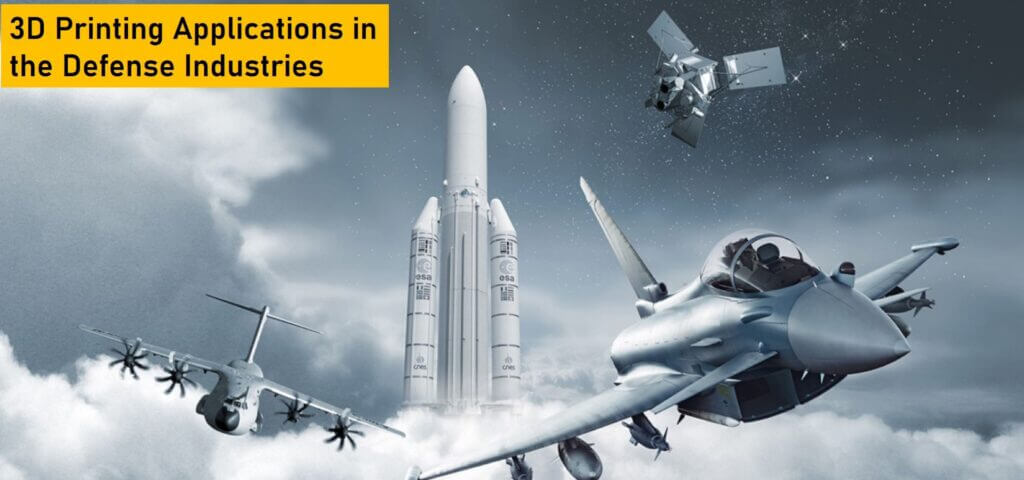The private and public firms in the defense industry leverage cutting-edge technologies to provide next-generation military capabilities to the army, navy, and air force. Additive manufacturing or 3D printing is one of the technologies that enable firms in the defense industry to optimize the research, development, production, and maintenance of a variety of military equipment and facilities.
That is why; the global military 3D printing market has been growing steadily. Many analysts and bloggers these days consider 3D printing as the future of defense manufacturing. Like other companies, defense organizations leverage plastic and metal 3D printing technologies to become a part of Industry 4.0.
Along with abandoning subtractive manufacturing methods, industrial-grade 3D printing machines create opportunities for the on-demand production of equipment and parts in remote locations. Also, 3D printing drives military R&D by facilitating concept testing and quick prototyping. We can assess the transformative impact based on a slew of 3D printing applications in defense industry.
Groundbreaking 3D Printing Applications in the Defense Industry in Recent Years
Accelerating Concept Testing and Prototyping
Defense is one of the industries that leveraged 3D printing technologies to drive R&D. Defense firms still use various 3D printing machines and materials for concept testing and rapid prototyping. Engineers find it easier to produce concept models and functional prototypes without using additional tools. Also, they reduce the time and resources required to perform validation testing by producing multiple variants of the prototype quickly and regularly.
Producing Spare Parts Remotely
Often countries carry out military operations in remote locations and harsh environments. Engineers find it challenging to repair and maintain vehicles and aircraft quickly in such adverse conditions. 3D printers make it easier for engineers to produce accurate and reliable materials on demand. Also, they replicate the spare part or installation tool by using the original CAD model and standardized materials. There are many 3D printing service providers that deliver spare parts to various locations for clients in the military industry.
Creating Innovative Tools
Often military professionals need innovative tools for vehicle maintenance. They have to wait for several days to get the tools delivered by the headquarter. But engineers in the US Navy use 3D printers to produce jigs to fix a common problem – removing steering wheels from metal. The initiative helped them reduce wait time as well as speed up vehicle maintenance. There are many instances when military organizations use 3D printers to facilitate the onsite printing of tools.
Printing Weapons and Structural Components
Since 2013, defense organizations have been 3D-printing parts instead of producing them. 3D printing creates opportunities for them to produce complex parts for military equipment. Also, engineers can use 3D printers to facilitate the low-volume production of end parts. At the same time, 3D printing creates opportunities for them to boost the performance of weapons and aircraft by reducing the weight of end parts. Most military organizations already invest in R&D to 3D-print weapons like missiles and grenade launchers.
Treating Battlefield Injuries
The number of injured soldiers always exceeds the number of dead soldiers after a war. In addition to improving the effectiveness of personal armor, military organizations have to focus extensively on treating battlefield injuries successfully. As a form of 3D printing, bioprinting helps military organizations to fabricate biomedical parts quickly and accurately. Defense forces can leverage bioprinting machines to produce patient-specific prosthetics and implants in various locations. Likewise, military medical personnel can use 3D printers to make surgeries successful by printing surgical tools and patient-specific models.
Building Military Infrastructure
Often governments set up remote and overseas military infrastructure to expedite military evacuations. They cannot build military infrastructure like airfields in a short amount of time using conventional manufacturing methods. Industrial 3D printers help governments set up military infrastructure in remote and obscure locations without investing extra time and resources. Recently, companies build expeditionary airfields in days by 3D-printing key components like runway mats.
Overcoming Material and Design Issues
Engineers have to overcome a slew of material and design challenges while producing personal armor using subtractive manufacturing methods. They leverage 3D printing technologies to overcome common material and design issues. 3D printers make it easier for them to design personal armor like combat helmets with complex geometries. At the same time, engineers can experiment with advanced materials that enhance soldier protection by improving impact absorption in varying environments.
Revamping Military Supply Chain
Like other enterprises, defense organizations spend a significant part of their budgets to streamline supply chain management. They have to sustain a network of defense contractors to ensure the supply of weapons, spare parts, and structural components across locations. But 3D printing creates opportunities for defense organizations to set up digital supply chains. Engineers can produce spare parts and structural components from CAD models using 3D printers. Hence, defense organizations are no longer required to incur warehouse expenditures or sustain a network of defense contractors.
Reducing Logistics Time and Cost
Defense organizations find it challenging to produce spare parts and structural components in remote locations due to skill constraints. But there are many companies and startups that have built a reputation by providing 3D printing services to clients in the defense sector. Military organizations get the parts or components printed locally by partnering with a reputable 3D printing service provider. The local 3D printing services help military organizations to reduce logistic time and cost simultaneously.
Conclusion
The steady growth of the global military 3D printing market depicts the transformative impact of additive manufacturing on the defense industry. In addition to increasing investment in additive manufacturing, defense organizations have been creating new use cases regularly. Hence, we will see many groundbreaking 3D printing applications in the defense industry in the near run.
However, we must focus on key challenges like skill gaps, quality assurance, and digital security while discussing various 3D printing applications in the defense sector. The US Department of Defense has already released an additive manufacturing roadmap to overcome these challenges. Most countries will announce similar roadmaps in the near run to transform defense industries by leveraging 3D printing technologies.

